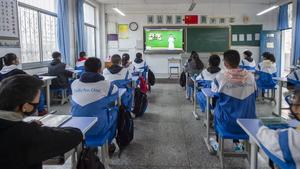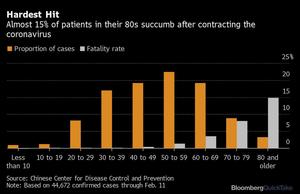 Students have a video class at a middle school in Yinchuan, northwest China's Ningxia Hui Autonomous Region, March 25, 2020. (YANG ZHISEN / XINHUA)
Students have a video class at a middle school in Yinchuan, northwest China's Ningxia Hui Autonomous Region, March 25, 2020. (YANG ZHISEN / XINHUA)
Children seem to be largely spared from the life-threatening complications of COVID-19, but they might be silently spreading the virus, doctors in China found.
Detailed analysis of 36 pediatric cases in China’s Zhejiang province found that the pandemic-causing coronavirus had little effect on their upper airways. Although fever, cough and pneumonia were the most common symptoms, about half the children had mild disease with no obvious signs - amounting to a “covert presentation,” researchers said Wednesday in the Lancet Infectious Diseases journal.
ALSO READ: Beijing isolation sites to release first batch of overseas travelers
Although small in scope, the Lancet study from China may be the most comprehensive analysis yet of pediatric patients with COVID-19, according to the authors. The findings suggest that infected children showing no clinical signs of disease are both difficult, and important, to find and isolate to stop the pandemic spreading.
The findings suggest that infected children showing no clinical signs of disease are both difficult, and important, to find and isolate to stop the pandemic spreading
The children, ages 1 to 16, were treated in the hospital for about two weeks with at least one antiviral drug. All patients, including so-called asymptomatic ones, took an average of 10 days to test negative for the coronavirus.
“The proportion of asymptomatic cases indicates the difficulty in identifying pediatric patients without clear epidemiological information,” Haiyan Qiu and colleagues wrote. “This finding suggests a dangerous situation if community acquired infections occur.”
The children recruited in the study were thought to have been mostly infected via close contact with family members or from living in an epidemic area.
The virus’s genetic material is shed in patients’ stools for a prolonged period, resulting in a “potential risk for transmission,” the authors said.
Older age is one of the biggest risk factors for developing a severe form of COVID-19. While some children are reported to have become critically ill, the risk of death among patients younger than 16 is extremely low, raising questions about the anatomy and immune system of children that helps them avoid the coronavirus’s potentially lethal effects.
 (BLOOMBERG GRAPHIC)
(BLOOMBERG GRAPHIC)
READ MORE: Medical workers go home from Hubei
Adult patients are more likely than pediatric cases to have an abnormally high level of a blood marker of inflammation, “suggesting a much milder immunological response in children and less immune damage,” the authors said.
A striking characteristic of COVID-19 is that it affects the lungs, heart and other vital organs, even in mild or moderate forms of the disease, they said.


